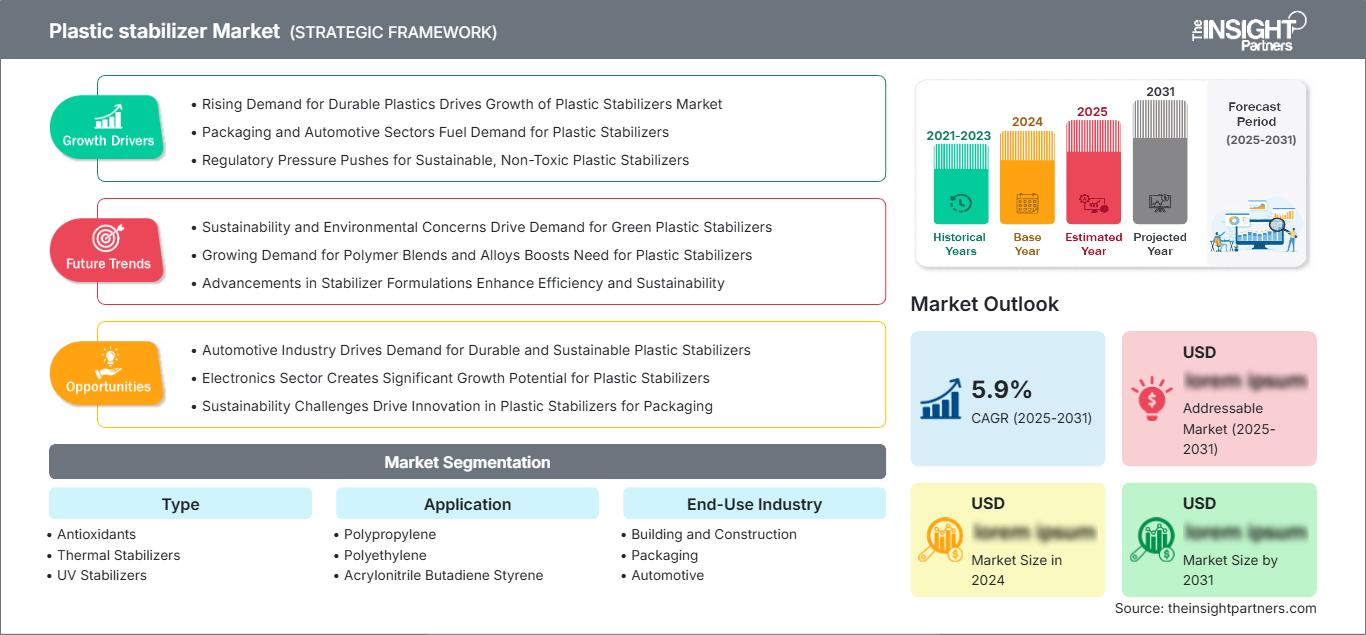预计塑料稳定剂市场在 2025 年至 2031 年期间的复合年增长率为 5.9%,市场规模将从 2024 年的 XX 百万美元扩大到 2031 年的 XX 百万美元。
本报告按类型(抗氧化剂、热稳定剂、紫外线稳定剂等)细分。报告进一步按应用(聚丙烯、聚乙烯、丙烯腈丁二烯苯乙烯、聚氯乙烯 (PVC)、聚氨酯等)细分。报告按最终用途行业(建筑和施工、包装、汽车、消费品、电气和电子、农业、医疗等)细分。报告范围涵盖五个地区:北美、欧洲、亚太地区、中东和非洲、南美和中美以及每个地区下的关键国家。全球分析进一步按区域和主要国家细分。报告以美元提供上述分析和细分的价值。
报告目的
Insight Partners 撰写的《塑料稳定剂市场》报告旨在描述当前形势和未来增长、主要驱动因素、挑战和机遇。这将为各业务利益相关者提供见解,例如:
- 技术提供商/制造商:了解不断变化的市场动态并掌握潜在的增长机会,使他们能够做出明智的战略决策。
- 投资者:对市场增长率、市场财务预测以及整个价值链中存在的机会进行全面的趋势分析。
- 监管机构:规范市场政策和警察活动,以最大程度地减少滥用,维护投资者的信任和信心,并维护市场的完整性和稳定性。
塑料稳定剂市场细分类型
- 抗氧化剂
- 热稳定剂
- 紫外线稳定剂
应用
- 聚丙烯
- 聚乙烯
- 丙烯腈-丁二烯-苯乙烯
- 聚氯乙烯
- 聚氨酯
最终用途行业
- 建筑
- 包装
- 汽车
- 消费品
- 电气和电子
- 农业
- 医疗
地理
- 北美
- 欧洲
- 亚太地区
- 南美和中美
- 中东和非洲
您将免费获得任何报告的定制,包括本报告的部分内容,或国家级分析、Excel 数据包,以及为初创企业和大学提供超值优惠和折扣
塑料稳定剂市场: 战略洞察

- 获取本报告的主要市场趋势。这个免费样本将包括数据分析,从市场趋势到估计和预测。
塑料稳定剂市场增长动力
- 耐用塑料需求增长推动塑料稳定剂市场增长:随着塑料在汽车、建筑、包装和消费品等行业的广泛应用,人们开始追求更高的耐用性以抵抗环境压力。紫外线稳定剂、抗氧化剂和热稳定剂等稳定剂可最大限度地提高塑料的耐用性和性能。塑料稳定剂有助于防止塑料因紫外线、热量和氧化而降解。因此,塑料产品可以在更长时间里保持可靠的物理状态。目前,户外使用塑料产品的持久耐用性已成为全球塑料稳定剂市场增长的重要因素之一。
- 包装和汽车行业推动塑料稳定剂的需求:包装和汽车行业是塑料稳定剂的最大消费者。随着人们越来越忙碌,越来越依赖电子商务和全球贸易,对更坚固、更美观的包装材料的需求也随之增长。稳定剂可以防止褪色,保持透明度,并改善食品饮料包装容器、化妆品和药品用塑料的机械性能。
- 监管压力推动可持续、无毒塑料稳定剂的发展:越来越多的政府出于环保考虑,对塑料产品中化学品的负责任使用实施更严格、更可持续的政策。例如,欧盟的《化学品注册、评估、许可和限制》(REACH) 和美国环保署的《有毒物质控制法案》(TSCA) 等化学材料强制塑料制造商在预定标准内使用稳定剂。因此,无毒或绿色稳定剂(例如生物基或无卤稳定剂)已成为一种趋势。这项法规推动了塑料稳定剂市场的创新,力求提供更环保、更安全的解决方案。
塑料稳定剂市场未来趋势
- 可持续性和环境问题推动对绿色塑料稳定剂的需求:环境问题和可持续性正日益成为塑料稳定剂市场的关键影响因素。消费者、生产商和监管机构都要求稳定剂无毒、可生物降解、对人体健康和环境友好。这导致了塑料稳定剂市场的范式转变,以生物基抗氧化剂、紫外线稳定剂以及非卤稳定剂等绿色稳定剂形式蓬勃发展。更重要的是,随着各行各业努力实现可持续发展目标并减少其产品的环境足迹,这些替代品正迅速成为首选。环保型稳定剂已成为各行各业采用的“绿色”塑料不可或缺的一部分。
- 聚合物共混物和合金需求的不断增长推动了塑料稳定剂的需求:聚合物共混物和合金应用的不断增长趋势源于汽车和建筑行业需求的增长。此类聚合物共混物将各种类型的塑料结合在一起,以实现优异的性能,例如更高的强度、柔韧性以及耐热和耐紫外线辐射。塑料稳定剂是此类应用中的重要组成部分,它通过保护聚合物链免受热、紫外线照射和氧化而降解,从而提供聚合物共混物的长期稳定性。随着聚合物共混物和合金的日益普及,对能够在各种塑料配方下有效工作的稳定剂的需求也在增长。
- 稳定剂配方的进步提高了效率和可持续性:稳定剂配方体系的进步也有助于提高其效率,同时减少其对环境的影响。这些进步包括具有抗氧化/紫外线防护特性的多功能稳定剂,以及可以在较低浓度下达到相同效果的高性能稳定剂。稳定剂配方中纳米技术的不断发展不仅提高了塑料的耐久性和使用寿命,而且其美观度也丝毫没有减弱。这些技术趋势往往会推动市场向更专业、更高效的稳定剂解决方案迈进。
塑料稳定剂市场机遇
- 汽车行业推动对耐用且可持续的塑料稳定剂的需求:汽车行业正在发生重大变革,对更轻、更耐用、能够在最恶劣条件下工作的零部件的需求不断增长。塑料稳定剂是制造汽车零部件(例如保险杠、仪表板、饰件和车身部件)的重要组成部分。随着行业向电动汽车和复杂设计的转变,对稳定剂的需求也很高,因为稳定剂可以提高塑料部件的热稳定性和紫外线稳定性。这种可持续汽车的日益增长的趋势也为在汽车应用中使用环保稳定剂提供了机会。电子行业为塑料稳定剂创造了巨大的增长潜力:电子领域也呈现出快速增长的势头,包括智能手机、笔记本电脑、消费电子产品和家用电器的生产。为了防止电子产品中的塑料因高温、紫外线辐射或导电性而降解,在极端操作条件下保持塑料材料的完整性至关重要。这一领域似乎是塑料制造中使用的稳定剂最大的增长机会之一。电子设备日益复杂,以及对耐用性和美观性部件的要求日益提高,将推动电子产品对专用塑料稳定剂的需求。可持续发展挑战推动包装用塑料稳定剂的创新:塑料稳定剂广泛应用于包装应用。随着可持续发展趋势的日益增强,环保稳定剂在包装应用中的创新和使用将面临严峻挑战。由于消费者和政府都强调减少浪费和使用可回收材料,制造商正在寻求能够提高塑料包装稳定性和可回收性的稳定剂。生物塑料和可堆肥包装材料的增长将为与此类材料兼容的新型稳定剂配方创造新的机会。
塑料稳定剂市场区域洞察
The Insight Partners 的分析师已详尽阐述了预测期内影响塑料稳定剂市场的区域趋势和因素。本节还讨论了北美、欧洲、亚太地区、中东和非洲以及南美和中美洲的塑料稳定剂市场细分和地域分布。
塑料稳定剂市场报告范围
| 报告属性 | 细节 |
|---|---|
| 市场规模 2024 | US$ XX million |
| 市场规模 2031 | US$ XX Million |
| 全球复合年增长率 (2025 - 2031) | 5.9% |
| 历史数据 | 2021-2023 |
| 预测期 | 2025-2031 |
| 涵盖的领域 |
By 类型
|
| 覆盖地区和国家 | 北美
|
| 市场领导者和主要公司简介 |
|
塑料稳定剂市场参与者密度:了解其对业务动态的影响
塑料稳定剂市场正在快速增长,这得益于终端用户需求的不断增长,而这些需求的驱动因素包括消费者偏好的不断变化、技术进步以及对产品优势的认知度不断提高。随着需求的增长,企业正在扩大产品线,不断创新以满足消费者需求,并抓住新兴趋势,从而进一步推动市场增长。

- 获取 塑料稳定剂市场 主要参与者概述
主要卖点
- 全面覆盖:本报告全面涵盖了塑料稳定剂市场的产品、服务、类型和最终用户的分析,提供了整体格局。
- 专家分析:本报告基于对行业专家和分析师的深入了解而编写。
- 最新信息:本报告涵盖了最新信息和数据趋势,确保了业务相关性。
- 定制选项:本报告可以根据特定客户需求进行定制,并使其与业务战略相得益彰。
因此,塑料稳定剂市场研究报告有助于引领解读和理解行业情景和增长前景的步伐。尽管可能存在一些合理的担忧,但本报告的总体优势往往大于劣势。
- 历史分析(2 年)、基准年、预测(7 年)及复合年增长率
- PEST和SWOT分析
- 市场规模、价值/数量 - 全球、区域、国家
- 行业和竞争格局
- Excel 数据集
近期报告
相关报告
客户评价
购买理由
- 明智的决策
- 了解市场动态
- 竞争分析
- 客户洞察
- 市场预测
- 风险规避
- 战略规划
- 投资论证
- 识别新兴市场
- 优化营销策略
- 提升运营效率
- 顺应监管趋势




















 获取免费样品 - 塑料稳定剂市场
获取免费样品 - 塑料稳定剂市场